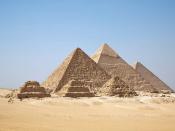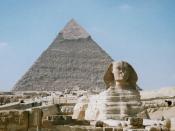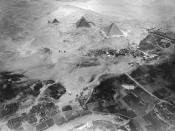The Egyptians believed that their kings were gods. Even after they had died, the
rulers continued to affect daily life through their supernatural powers. In his new life in
the underworld, the king would need everything he needed while alive, and he needed his
home to last for eternity.
While alive, Egyptian kings lived in palace of mud-brick, wore linen roves, and
slept in wooden beds. In their gentle climate, more substantial comforts were not
needed. But eternity last a whole lot longer than life. So the tombs of the kings needed
to be durable and well-supplied. The tombs also needed to protect the body and its
supplies and gifts from thieves. They also were the focus of the Egyptian religion and so
needed to be extremely visible. The massive stone pyramid met all these criteria.
However, there was still the problem of supplying the king with essentials. Since
entombing a never-ending supply of food and servants was not very practical, the
Egyptians decided on the principal of "substitution by means of a representation."
Since
the dead king now existed in spirit, rather than physical form, he was not bound by
physical limitations. A picture or word could feed him as well as a real slab of meat.
Servants did not have to be killed and laid around his tomb; statues could take their
place.
Because the king was a god to his people, they needed to be able to come and
worship him. But if his body were accessible to the whole nation, the king and his
treasures would be too accessible to robbers. So, instead they built a statue resembling
the king which they placed in a temple open to the public. His ka, or spirit could leave
the tomb and come live in his statue for awhile.


